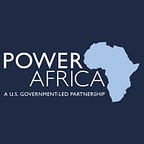Fostering Regional Collaboration & Trade in the Power Sector of The Gambia River Basin
By connecting The Gambia and Senegal’s power grids, electricity prices are falling and accessibility is increasing
Leveraging the power of interconnectivity, Senegal and The Gambia have inaugurated a shared electricity network in line with Power Africa’s goal to expand the supply of and access to affordable and reliable electricity services.
Regional Collaboration and Capacity Building
These two neighbors in West Africa form half of the Gambia River Basin Development Organization (OMVG), alongside Guinea and Guinea-Bissau. OMVG aims to increase cross-border power trade through the development of interconnected networks and improved electricity supply.
Until now, almost half of The Gambia’s population lacked access to electricity, and residents were subject to paying one of the highest electricity tariffs in the region, exceeding $US0.26/kWh.
By linking its network with Senegal, The Gambia has facilitated thousands of connections to the grid, has experienced a 43 percent drop in the cost of electricity generation, and is improving its overall grid resilience.
Moreover, the interconnection bolsters the Economic Community of West African States (ECOWAS) West African Power Pool (WAPP) goal of developing a unified regional electricity market. WAPP facilitates the building, commissioning, and activation of formal power trade between connected countries in West Africa — the same goal as OMVG on a region-wide scale.
Through its work with OMVG, alongside the African Development Bank and the World Bank, Power Africa provided technical, policy, and advisory support to ensure smooth and efficient electricity flows between Senegal and The Gambia and across OMVG countries.
In 2022, Power Africa helped the Gambian utility, National Water and Electricity Company (NAWEC), in its integration effort into OMVG’s regional power market — specifically, the ability to trade power with SENELEC, Senegal’s national electricity company.
To facilitate this cross-border trade, Power Africa supported the development of transmission services agreements for the OMVG network and developed operations, maintenance, and monitoring best practices to align the grid codes of NAWEC and SENELEC within OMVG.
At the same time, Power Africa worked closely with the OMVG project management unit to provide trainings and roadmaps in reporting, data control systems, information sharing, social safeguards, and community engagement during line construction and maintenance.
Achieving Results
NAWEC and SENELEC signed a five-year power purchase agreement (PPA) through the newly constructed Kaolack-Soma-Brikama 225kV line within the scope of the OMVG Energy Project. Under the PPA, SENELEC initially allocated and deployed 30MW of power to The Gambia, with the potential of increasing deployment up to 50MW.
Most critically, through this interconnection, the two utilities are agreeing to tariff rate at about $US0.15/kWh at which NAWEC can import, almost half of the prevailing average generation cost. With the new import rate for NAWEC, the project can increase its revenue collection and its operational capacity.
Power Africa’s work with OMVG has resulted in at least 60,000 connections in the country across more than 300 villages in the vicinity of Soma and Brikama substations.
While the first Senegal-Gambia interconnection line is complete, Power Africa’s support to OMVG continues. In 2023, Power Africa is set to assist in implementing a WAPP-developed Project Implementation Manual. OMVG staff will be trained in project performance reporting, monitoring and evaluation, and geographical information systems technologies, in an effort to improve the management of output and impact between OMVG member countries.
In addition, previously, the entirety of The Gambia’s power generation was based on heavy fuel oil. Through the OMVG Energy Project, the country is pushing to diversify power generation sources through clean energy sources such as solar, lowering the demand for local fossil fuel generation and leading to a reduction in CO2 emissions. Meanwhile, Senegal already produces more than 20 percent of its electricity from renewables and is increasing renewable energy supply through a Power Africa-supported Energy Transition Plan.
By connecting electricity networks across the Gambia River Basin, Power Africa partners are electrifying The Gambia’s rural communities, providing people with access to improved public services and reducing electricity prices for homes, schools, and hospitals.
